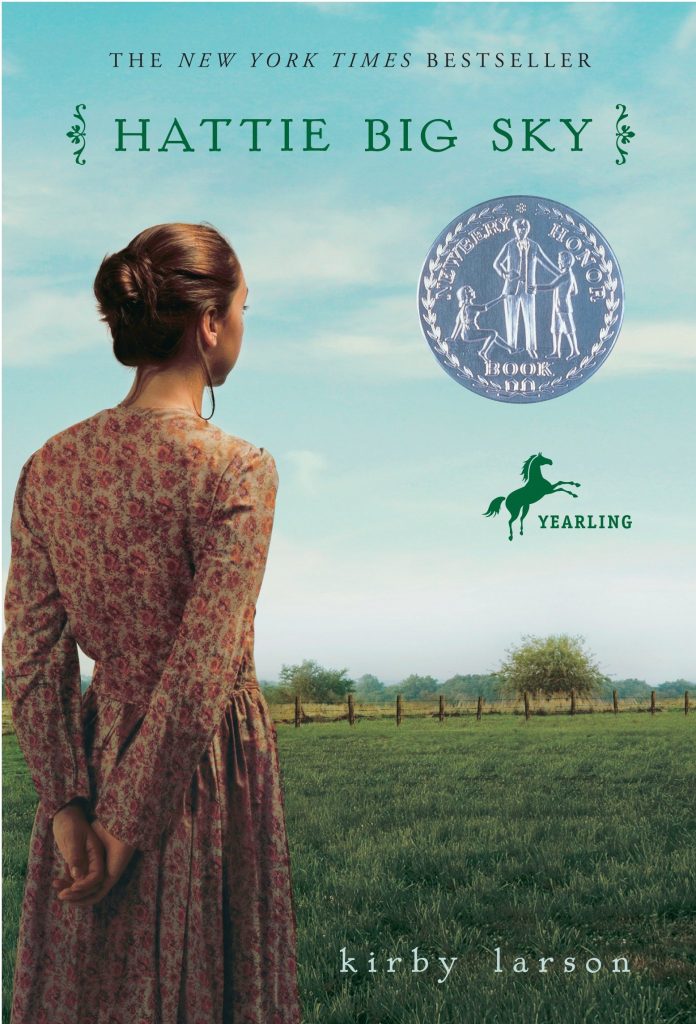
BIBLIOGRAPHY
Larson, Kirby. Hattie Big Sky. New York: Delacorte Press, 2006. ISBN 9780385733737
PLOT SUMMARY
Hattie has been moving from house to house for almost as long as she can remember. This time, she’s been taken in by her distantly related aunt and uncle, although Aunt Ivy hopes to get rid of the orphan by employing her at the local boardinghouse. But Aunt Ivy’s plans are dashed unexpectedly when Hattie’s late uncle leaves her a homesteading claim in rural Montana. At just sixteen years old, Hattie takes an Iowa train west, hoping for a place to finally call home. But first she’ll have to appease an angry cow, brave the cruel winter weather, learn how to cook, make friends with strangers, cultivate forty acres of land, and set 480 rods of fence, all by herself. Things don’t always go smoothly in Hattie’s neck of the woods. Local prejudice against German immigrants—like her friendly neighbor, Karl—are high due to nationwide anti-German sentiment; the weather makes Hattie wonder if she’ll ever get a crop; and she worries for her childhood friend and pen pal, Charlie, who is off fighting World War I across the sea. Yet, Hattie never loses her grit and positive outlook. Daily conversations with God ease Hattie’s lonely existence along with blossoming friendships with homesteading neighbors, even when tragedy strikes. Although Hattie’s story may not be a perfectly painless one, it is surely one of determination and of hope.
CRITICAL ANALYSIS
Hattie’s story—the story of a sixteen-year-old orphan turned homesteader—isn’t a sugar-coated one. When Hattie first arrives at her new abode in the middle of nowhere, snowdrifts and mouse droppings greet her from inside the tiny shanty house. Hattie’s first few months are spent freezing, scaring off a hungry wolf, and trying to learn how to bake bread instead of the grain bricks that keep coming out of the oven. Putting down fenceposts in the muddy spring isn’t much easier, nor is the planting stage that comes a little while later. On every step of Hattie’s homesteading journey, she must confront an obstacle, each one seemingly more unsurmountable than the last. But Hattie’s no slouch. Her gumption and can-do attitude made Hattie easy to like and her ability to laugh at herself will have readers guffawing along with her.
While the story of one pioneering orphan girl in 1917 may seem completely different from the world of today, Hattie’s story is also a timeless one. Hattie refers to herself as “Hattie Here-and-There,” never feeling like she has a place in the world where she is truly at home. And while Hattie writes to Charlie, a childhood friend who fights the Germans across the ocean, she also befriends a German immigrant, Karl Mueller, and his wife and children. In an America embroiled in World War I, German immigrants are treated with suspicion and, in some cases, with outright cruelty. Through Hattie, the author addresses prejudice, friendship, belonging, and courage, themes that continue to resonate with tween and teenage readers today.
What makes this book truly special is that it is both resonant with its readers and true to its historical period. The story is thorough in its research and authentic in its voice. Kirby Larson’s end notes shed light on her extensive research process as the book’s author, including reading dozens of homesteaders’ journals and books about the “honyockers” of Montana. Recipes for Perilee’s Wartime Spice Cake recipe and Hattie’s Lighter-than-Lead Biscuits found in the back matter are another fun (and delicious-looking) addition that interested readers will be excited to try. And Larson’s revelation that Hattie’s story is based loosely on the life of the author’s own great grandmother will delight readers and may spark a newfound love of history. Although Hattie Big Sky doesn’t end with a traditional happily ever after, this story is sure to be a popular favorite on any bookshelf.
AWARDS AND REVIEW EXCERPTS
John Newbery Medal Honor Book, 2007
School Library Journal Best Books List for Grade 6–8, 2006
YALSA Best Books for Young Adults List, 2007
From Kirkus: “This fine offering may well inspire readers to find out more about their own family histories.”
From Booklist: “The authentic first-person narrative, full of hope and anxiety, effectively portrays Hattie’s struggles as a young woman with limited options, a homesteader facing terrible odds, and a loyal citizen confused about the war and the local anti-German bias that endangers her new friends. . . . Writing in figurative language that draws on nature and domestic detail to infuse [Larson’s] story with the sounds, smells, and sights of the prairie, she creates a richly textured novel full of memorable characters.”
CONNECTIONS
- Share Kirby Larson’s revelation that Hattie’s story is based loosely on the life of the author’s own great grandmother. Ask teens to learn more about their own family histories. Then have a special family history event where teens can share their favorite family stories orally, through pictures and art, or through written storytelling.
- As part of a library youth book club, read Hattie Big Sky together. Then have a Hattie Big Sky party, complete with a “barn dance” and the recipes found in the back of the book.
- Set out a teen book display featuring books set during World War I, such as the following:
- Berry, Julie. Lovely War. ISBN 9780451469939
- Westerfeld, Scott. Leviathan.ISBN 9781416971733
- Murphy, Jim. Truce. ISBN 9780545130493
- Put out a display of all the 2007 Newbery Award finalists including Hattie Big Sky. Then allow middle-graders and teens to vote on their favorite title and hold an awards ceremony for the favorite pick.
- Patron, Susan, and Matt Phelan (illustrator). The Higher Power of Lucky. ISBN 9781416901945
- Holm, Jennifer L. Penny from Heaven. ISBN 9780375836879
- Lord, Cynthia. Rules. ISBN 9780439443821
*Note—This book review was created as an assignment for a course at Texas Woman’s University.